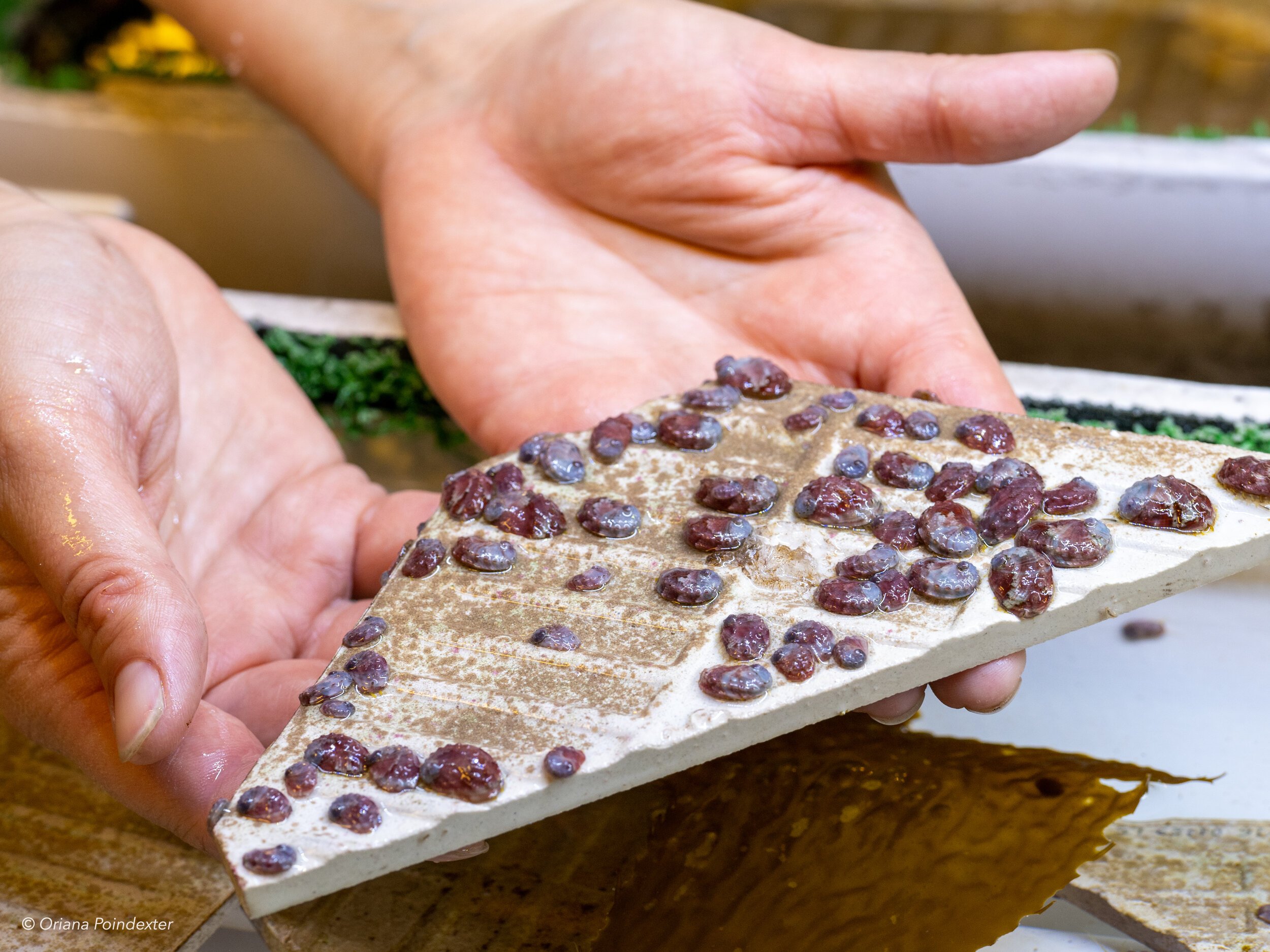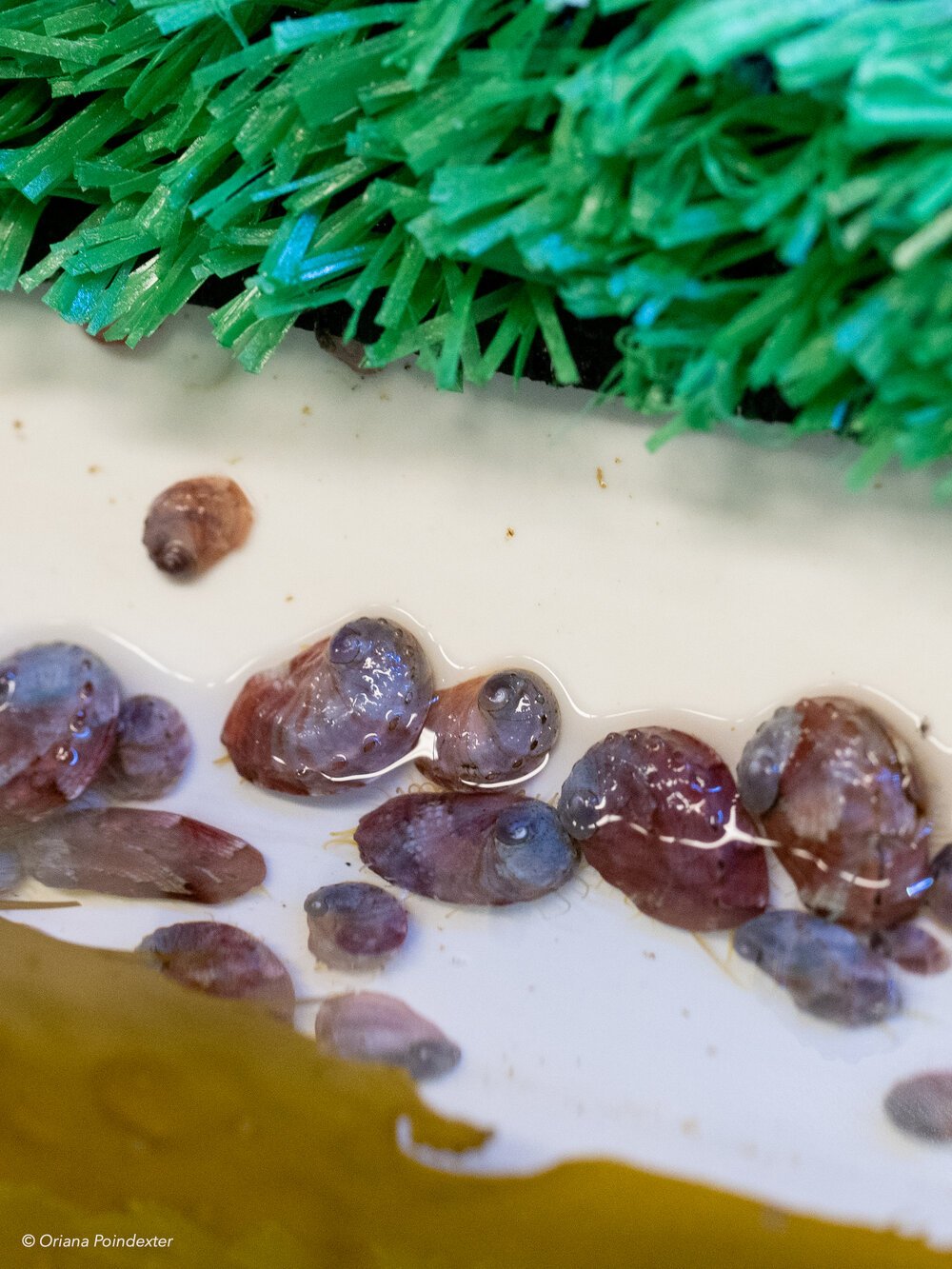Foster Care for Endangered White Abalone at the Aquarium of the Pacific
I visited the Aquarium of the Pacific in Long Beach on an unseasonably hot day in early April. The Aquarium had recently reopened to the public, with visitors required to pre-order tickets for set time slots to accommodate social distancing. It was not my first time visiting, but it was my first visit to a public place of this type since pre-pandemic.
I enter through the staff door after a quick temperature check, and meet Briana Fodor, a Senior Aquarist. Briana ushers me ‘behind the scenes’ into a small, blue-lit room, behind the tanks the public get to see. We’re on the business end of the Aquarium’s Abalone Exhibit in the Southern California/Baja Gallery, which houses red abalone (Haliotis rufescens), endangered white abalone (H. sorenseni), and plenty of their food, giant kelp (Macrocystis pyrifera).
More than fifty white abalone (H. sorenseni) sit on this tile, pulled briefly out of the fresh seawater tank for a photo. Senior Aquarist Briana Fodor’s hands give you a sense of just how small these young abalone are. These tiles are used to increase the surface area for abalone settlement in their tanks.
Briana’s responsibilities at the Aquarium include caring for over four thousand of these endangered snails. In the quiet back room behind the public abalone display are a set of four, three foot long white troughs, where thousands of fingernail-sized white abalone quietly grow larger, day by day.
The Aquarium of the Pacific is one of fifteen institutional partners that compose the White Abalone Restoration Consortium (WARC) [1]. The white abalone, one of seven abalone species found off the U.S. West Coast, holds the dubious distinction of being the first marine invertebrate to be listed as endangered under the U.S. Endangered Species Act. The WARC, led by NOAA Fisheries, works to support the restoration of white abalone populations through conservation actions, increased public awareness, and specifically, by developing and running a successful captive breeding and outplanting program. My work here is part of the effort to increase public awareness in partnership with NOAA, and supported by the National Marine Sanctuary Foundation.
Abalone play the numbers game. Each adult abalone spews millions of eggs or sperm into the water column each time they spawn. That’s the extent of their parental care. Abalone parents anticipate that up to 99% of their larval offspring will die. They’re fine with those odds. As long as a few of their offspring survive to adulthood, the parents have replaced themselves, and the population will persist. For white abalone, this strategy hasn’t been working in the wild for decades. There aren’t enough white abalone, close enough together, to achieve success through broadcast spawning.
People in California started trying to breed abalone in captivity in 1940 at the Hopkins Marine Station. Early on, the goal was to “seed” wild populations to support commercial and recreational fisheries. A fisherman-scientist partnership in the mid-1960s managed to successfully spawn abalone and released thousands of larvae into the waters of Central California. The issue, both then and now, is how to track and manage the massive mortality that occurs in the early life stages. When those first larvae were released into the wild, the group admitted they “did not have any method of evaluating” the survival of the released animals, and therefore, the success of their effort [2].
Briana Fodor, Senior Aquarist, looks over her small charges at the Aquarium of the Pacific. If you look closely, you’ll recognize many triangular tiles, like the one in the previous image, lining these long tanks.
Young white abalone congregate at the water’s edge of their tanks at the Aquarium of the Pacific. The artificial turf at the top of the image prevents them from wandering out of the tank, into thin, dry air.
On land, abalone are born in buckets. When I visited the Cultured Abalone Farm in March 2021, I peered into a series of white five-gallon buckets and saw larval red abalone. Filled about three-quarters of the way with seawater, the buckets were speckled throughout with what looked like tiny sesame seeds. Each of the specks was a few-day-old baby abalone, and there were millions in every bucket.
In captivity, abalone are motivated to release their eggs or sperm with a concoction containing hydrogen peroxide, which usually convinces the animals that the time is right. Each adult abalone has the capacity to release millions of eggs or sperm, which meet and mix in the water column to produce larvae. It’s these larval animals that I saw suspended, sesame seed-like, in the white buckets.
The majority of the white abalone breeding happens at the UC Davis Bodega Marine Lab (BML), where tens of thousands of animals are produced each year from a captive population of adult white abalone known as broodstock. The Aquarium of the Pacific has also successfully spawned captive white abalone in the past, but today, is primarily involved in the raising of young white abalone.
The four thousand endangered youngsters here in Long Beach at the Aquarium of the Pacific are essentially in foster care. After a successful spawning event, their parents in Bodega Bay produce more abalone than the Bodega Marine Lab can physically house and care for, so the scientists are faced with the challenge of finding a place for hundreds of thousands of endangered animals to settle and grow.
This has resulted in some heroic relocation efforts, as the baby abalone need to be quickly distributed among the WARC partners with the space, facilities, expertise, and resources to care for thousands of endangered foster snails. They need a place to grow up from the size of a sesame seed to about two inches in shell length, when they’ll be ready for outplanting into the Pacific Ocean.
Pre-pandemic, this meant that tens of thousands of baby white abalone had been transported across the state of California by pairs of drivers in cars and trucks, switching off at the wheel to make the long distance all in one go. The pandemic threw a curve ball into that strategy as well, as it’s no longer advisable for two people who don’t live together to drive in the same vehicle.
Thanks to pandemic restrictions on humans, these young abalone became jet-setters. They were flown down from Bodega Bay to Long Beach in a private plane, thanks to a non-profit organization that pairs volunteer pilots with environmental causes in need of a flight [3].
After a safe landing, the white abalone were quickly transferred into their foster homes. They’ll live in long troughs irrigated with fresh sea water, pumped directly from the Pacific Ocean and kept oxygenated with air pumps, like a cold, salty jacuzzi with all the jets blasting.
Here at the Aquarium of the Pacific, they’re fed freshly harvested giant kelp on a bi-weekly basis as they grow up. They are well taken care of with their ultimate destination in mind - one of two secret locations in the Pacific Ocean off the Southern California coast, where thousands of their cousins have already been released, beginning in November 2019 [4]. These four thousand youngsters are part of the effort to recover white abalone populations in the wild, and once released, they are monitored regularly by divers. In fact, the Aquarium of the Pacific, through its partnership with the WARC, was the first public aquarium to outplant white abalone back into the wilds of the Pacific Ocean.
After talking with Briana about her work and photographing the young white abalone, I venture out into the public viewing area to see the adults in their habitat display. It takes me a moment to adjust, as the dim lighting typical of aquariums seems to amplify some unfamiliar sensations I’m experiencing.
There are people all around, even at a social distance. Children shriek in excitement at the moray eel putting on a show in the next tank over, young couples hold each other close as they point into the tanks and laugh, and parents struggle to answer their kid’s questions about marine life while herding their families through the exhibits. The cacophony of a public gathering place washes over me, as I realize I haven’t experienced these sights and sounds in over a year. I stand back and watch the humans go by, with the tank of adult abalone munching on kelp as the backdrop to the scene.
Adult white abalone (H. sorenseni) on display to the public in the Abalone Exhibit, part of the Southern California/Baja Gallery at the Aquarium of the Pacific.
Read more about white, black, and red abalone in The Iridescent Ones blog series here.
To learn more about the Aquarium of the Pacific or to schedule a time to visit in person, visit their website. Learn more about endangered white abalone and the conservation efforts for the species at NOAA Fisheries.
Thank you to the National Marine Sanctuary Foundation for continued support of this work.
References
White Abalone Restoration Consortium. University of California Davis Coastal and Marine Sciences Institute.
Lundy, A.L. (1997). The California Abalone Industry, a Pictorial History. Best Publishing Company, Flagstaff Arizona. 120 pp.
Connelly, Laylan. “11,000 Baby Abalone Will Be Planted at a Secret Spot off the Southern California Coast.” Daily Breeze, Orange County Register, 26 Feb. 2021.
NOAA Fisheries. “Divers Release Endangered Abalone into the Wild for First Time, Boosting Odds of Recovery.” 25 Nov 2019.




